When there are signs of opioid overdose, taking immediate action can be lifesaving. Patients and their close family and friends should know when to call for emergency help and what to do while waiting for help to arrive. Keep the information below in a handy place where you can always find it.
 Download PDF version of this page in English <click here>
Download PDF version of this page in English <click here>
 Descargue en PDF la versión en Español <haga clic aquí>
Descargue en PDF la versión en Español <haga clic aquí>
 |
Can you wake up the person?
 Shout their name, pinch their ear, or rub your knuckles on the middle of their chest. Shout their name, pinch their ear, or rub your knuckles on the middle of their chest.
- If the person does not respond at all, call for emergency help right away!
- While you are waiting for help to come...
- If the person is breathing, put them in the Recovery Position.
- If they are not breathing, start Rescue Breathing.
- If there is no heartbeat, start CPR.
|
|
| Recovery Position |
|
Gently tilt the person's head back so they can breath easier.
- Straighten their legs and roll the person to face you.
- Pull the bottom arm to be at a right angle to their body, and bend the arm upward at the elbow.
- Pull the other arm across the person's chest and place their hand against their cheek to help support the head.
|
|
- Grabbing just above the knee, pull the person's upper leg toward you until they are on their side.
|
|
- Finally, place upper leg at a right angle to keep the person from rolling over further.
- Be sure their hand is supporting the cheek and the head is tilted back for easier breathing.
Check that their mouth is clear of any chewing gum, food, or vomit.
- Stay with the person until help comes.
<Practice putting a friend or relative into the Recovery Position.>
|
|
CAUTION: The lifesaving steps below are for your information. You should get training to do them properly. This is available from Red Cross chapters around the world. Look in the phone book for the nearest Red Cross chapter, or to find locations in the USA <visit here>.
The American Heart Association also offers classes; to find one near you, <click here>.
|
| Rescue Breathing in Adults |
|
Is the person breathing?
- Roll the person onto their back.
- Gently tilt their head back to open the airway (push down on their forehead and support the chin to keep the head back).
- Make sure their mouth is clear of chewing gum, food, or vomit.
- Lean close to feel on your cheek and hear if there are breaths.
If there is no breathing, you will need to do mouth-to-mouth rescue breathing. Otherwise, the person may suffer brain damage.
|
|
- For rescue breathing, first pinch the person's nostrils together between your thumb and first finger.
- Make a good seal around the person's lips with your mouth and blow steadily until their chest rises. Then take your mouth away and let their chest sink back down.
- Repeat the breathing, giving 1 breath every 5 seconds. Always keep the person's head tilted back and the airway open.
|
|
| CPR (Chest Compressions or 'Pumps' & Rescue Breathing) in Adults |
|
If both breathing and heartbeat stop, there is no pulse and CPR (cardio-pulmonary resuscitation) may keep the person alive until help comes.
- First, give 2 rescue breaths (see above).
- Place the heel of one hand on the breastbone in the center of the chest and put the other hand on top, locking your fingers together.
|
|
- Next, keep your shoulders above the center of the person's chest, arms straight, and push down on their chest by about 2 inches. Quickly release the pressure, but keep your hands where they are.
- Do 30 fast down-then-up chest pumps in about 20 seconds, followed by 2 breaths of rescue breathing. Repeat this cycle until help comes.
- If the person's heart starts beating, and their normal color returns, stop chest pumps but still do rescue breathing unless they wake up.
 If you have not been trained in rescue breathing, or cannot do it for some reason, you should still do the rapid chest pumps. This is called "Hands-Only CPR". If you have not been trained in rescue breathing, or cannot do it for some reason, you should still do the rapid chest pumps. This is called "Hands-Only CPR".
|
|
![]() Download PDF version of this page in English <click here>
Download PDF version of this page in English <click here>![]() Descargue en PDF la versión en Español <haga clic aquí>
Descargue en PDF la versión en Español <haga clic aquí>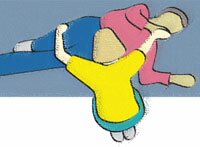



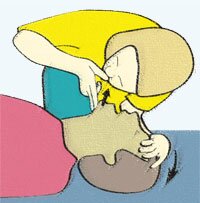
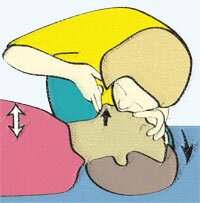
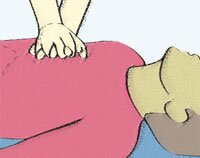
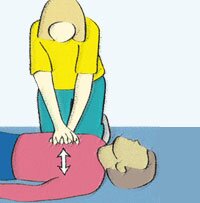


 Shout their name, pinch their ear, or rub your knuckles on the middle of their chest.
Shout their name, pinch their ear, or rub your knuckles on the middle of their chest. If you have not been trained in rescue breathing, or cannot do it for some reason, you should still do the rapid chest pumps. This is called "Hands-Only CPR".
If you have not been trained in rescue breathing, or cannot do it for some reason, you should still do the rapid chest pumps. This is called "Hands-Only CPR".